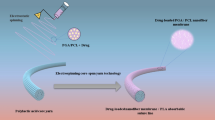Abstract
The drug-release time of suture should meet with the healing time of wound, so it is needed to control the drugrelease performance of polylactic acid (PLA) suture. In this paper, two biodegradable polymers with different degradation rates, such as polycaprolactone (PCL) and polyglycolide (PGA), were applied to carry the drug of tea polyphenol (TP). The drug-loading finishing solution which is made of PCL/PGA carriers and TP, was coated on the PLA suture. The drug-release rate and time of PLA suture could be regulated by adjusting the proportion of PCL/PGA carriers. The results indicate that the surface of drug-loaded PLA suture becomes rough. There is no obvious chemical reaction among the drug, carriers and PLA suture, just physical adhesion. With the increasing of PCL in drug-carriers, the strength of suture gradually increases. At 70/30 of PCL/PGA, the fracture elongation of suture reaches the highest point. In process of degradation, the surface of drugloaded PLA suture appears some holes after 25 weeks. The strength of sutures decreases gradually during degradation, and the effective strength time of sutures with various proportions of PCL/PGA is different. The drug-release rate of the suture is fast at early stage and slow at later stage and the higher the PGA proportion is, the faster the drug-release rate of the suture is.
Similar content being viewed by others
References
C. Lou, C. Yao, Y. Chen, T. Hsieh, J. Lin, and W. Hsing, Text. Res. J., 78, 958 (2008).
A. Vieira, R. Medeiros, R. Guedes, A. Marques, and V. Tita, Mater. Sci. Forum, 732, 56 (2013).
X. Sui, S. Wang, Y. Li, and L. Xu, Chinese J. Sensor. Actuat., 30, 157 (2017).
W. Zhang, Z. Chen, S. Ma, Y. Wang, F. Zhang, K. Wang, C. Yang, X. Pu, J. Ma, Y. Wang, F. Leng, F. Ran, and Y. Kuang, Int. J. Polym. Mater. Polym. Biomat., 65, 38 (2016).
I. Arrnentano, N. Bitinis, E. Fortunati, S. Mattioli, N. Rescignano, R. Verdejo, M. A. Lopez-Manchado, and J. M. Kenny, Prog. Polym. Sci., 38, 1720 (2013).
S. Liu, G. Wu, H. Guo, Z. Zuo, and J. Dai, J. Donghua Univ. Engl., 32, 97 (2015).
B. Tyler, D. Gullotti, and A. Mangraviti, Adv. Drug Deliver. Rev., 107, 163 (2016).
K. Alicja, C. Marco, B. Tomasz, S. Krisztina, B. Andrea, B. Jan, and S. Wojciech, Biofabrication, 9, 044105 (2017).
A. Visco, D. Nocita, A. Giamporcaro, S. Ronca, G. Forte, A. Pistone, and C. Espro, J. Mech. Behav. Biomed., 68, 308 (2017).
L. Zhang, J. Song, and W. Wang, J. Med. Theor. Pract., 29, 2040 (2016).
D. H. Lee, T. Y. Kwon, K. H. Kim, S. T. Kwon, D. H. Cho, S. H. Jang, J. S. Son, and K. B. Lee, Polym. Bull., 71, 1933 (2014).
T. Matsuda, T. Iwasaki, M. Mitsutsuji, K. Hirata, Y. Maekawa, D. Tsugawa, Y. Sugita, E. Shimada, and Y. Kakeji, Surg. Endosc., 29, 3386 (2015).
O. Buezo, X. Cusco, R. Seijas, A. Sallent, O. Ares, P. Álvarez-Díaz, and R. Cugat, Surg. Innov., 22, 474 (2015).
I. Bonadies, F. Cimino, C. Carfagna, and A. Pezzella, Biomacromolecules, 16, 1667 (2015).
P. Sibanda, X. Chen, and L. Wang, Prog. Biomed. Eng., 35, 13 (2014).
D. M. Correia, C. Ribeiro, G. Botelho, J. Borges, C. Lopes, F. Vaz, S. A. C. Carabineiro, A. V. Machado, and S. Lanceros-Méndez, Appl. Surf. Sci., 371, 74 (2016).
G. Gorrasi, R. Pantani, M. Murariu, and P. Dubois, Macromol. Mater. Eng., 299, 104 (2014).
Y. He, Z. W. Hu, M. D. Ren, C. K. Ding, P. Chen, Q. Gu, and Q. Wu, J. Mater. Sci. Mater. El., 25, 561 (2014).
J. W. Qin, Y. Y. Jiang, J. J. Fu, Y. Q. Wan, R. H. Yang, W. D. Gao, and H. B. Wang, Iran. Polym. J., 22, 729 (2013).
S. H. Lee, I. Y. Kim, and W. S. Song, Macromol. Res., 22, 657 (2014).
W. J. Xu and Y. Q. Yang, J. Biomat. Sci. Polym., 21, 445 (2010).
G. H. Wu, S. Q. Liu, H. S. Jia, and J. M. Dai, J. Wuhan Univ. Technol., 31, 164 (2016).
Thimour-Bergstrom, C. Roman-Emanuel, H. Schersten, O. Friberg, T. Gudbjartsson, and A. Jeppsson, Eur. J. Cardiothorac., 44, 931 (2014).
W. G. Zhou, H. P. Qian, L. S. Yan, D. Luo, N. Xu, and J. X. Wu, Mater. Lett., 152, 293 (2015).
K. Maeda, H. Yasui, T. Matsuura, T. Yamamori, M. Suzuki, M. Nagane, J. M. Nam, O. Inanami, and H. Shirato, J. Radiat. Res., 57, 307 (2016).
W. H. Zhou, M. R. Du, L. Dong, X. Y. Zhu, J. Y. Yang, Y. Y. He, and D. J. Li, Hum. Reprod., 22, 2743 (2007).
R. Augustine and K. Rajarathinam, Int. J. Nano Dimens., 2, 205 (2012).
S. Padmakumar, J. Joseph, M. H. Neppalli, S. E. Mathew, S. V. Nair, S. A. Shankarappa, and D. Menon, ACS Appl. Mater. Inter., 8, 6925 (2016).
B. Joseph, A. George, S. Gopi, N. Kalarikkal, and S. Thomas, Int. J. Pharmaceut., 524, 454 (2017).
Author information
Authors and Affiliations
Corresponding authors
Rights and permissions
About this article
Cite this article
Liu, S., Wu, G., Zhang, X. et al. Degradation and Drug-release Behavior of Polylactic Acid (PLA) Medical Suture Coating with Tea Polyphenol (TP) - Polycaprolactone (PCL)/Polyglycolide (PGA). Fibers Polym 20, 229–235 (2019). https://doi.org/10.1007/s12221-019-8829-8
Received:
Revised:
Accepted:
Published:
Issue Date:
DOI: https://doi.org/10.1007/s12221-019-8829-8




